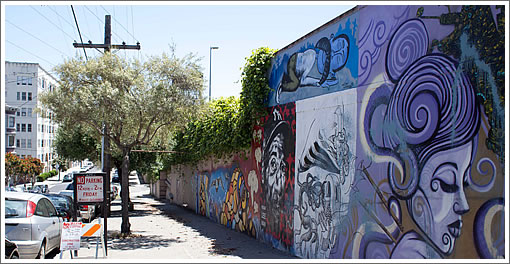
As Laguna Street between Haight and Hermann in San Francisco currently appears above, as the streetscape will appear after the development of 55 Laguna as proposed below.
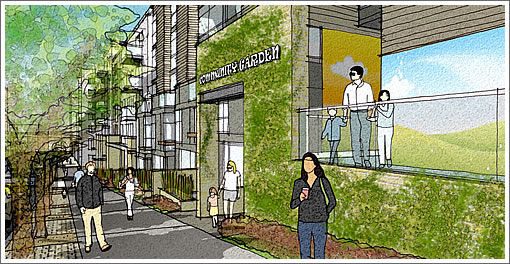
In addition to rehabilitating the existing Richardson and Woods halls, the proposed project will include ten new buildings with courtyards, a community garden, a new pedestrian street (“The Mews” or “Palm Lane”) and the new Waller Park at its core.
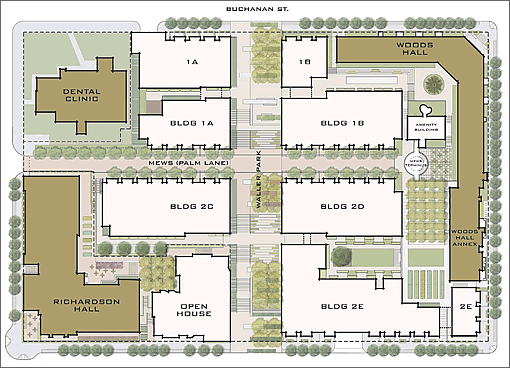
The historic buildings on the site “were designed in the Spanish Colonial Revival style and have a quiet, inward-looking character” while the new buildings will have a contemporary design and “will be recognized as buildings of their own time.”
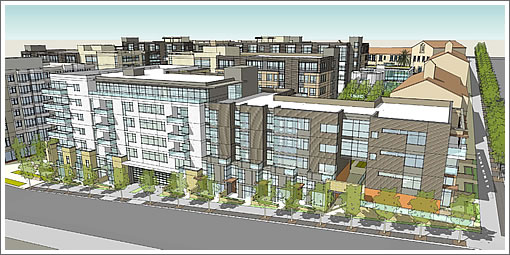
The buildings are “neither quiet nor inward-looking,” intended to bring vitality to the street.
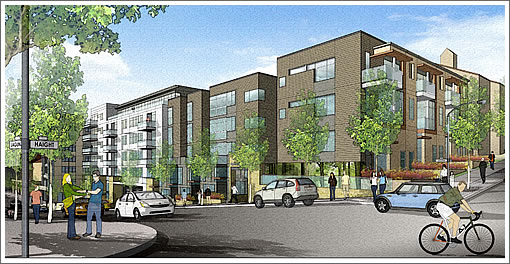
The new buildings “will have a scale that is sensitive to the existing buildings, especially at adjacencies. Roof lines will be used to guide heights and setbacks. The massing of the new buildings will be broken down to reduce their apparent scale on the site.”
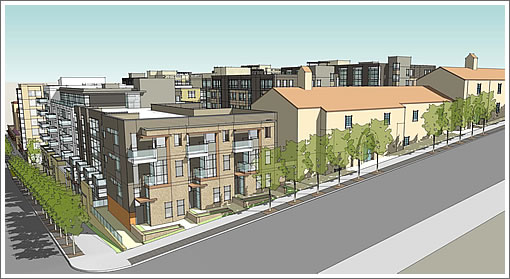
The project includes an Amenity Building and circular outdoor stair, the “Mews Terminus,” built in formed concrete and glass for some extra modern flair.
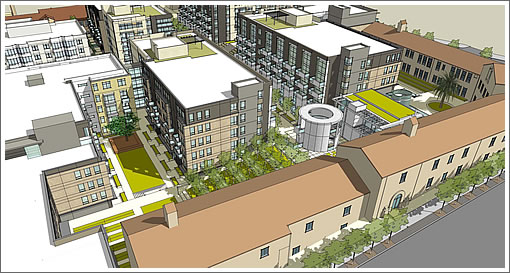
The project is designed and “organized in a way that allows the site to be accessible to both the future residents and the surrounding neighborhood.”
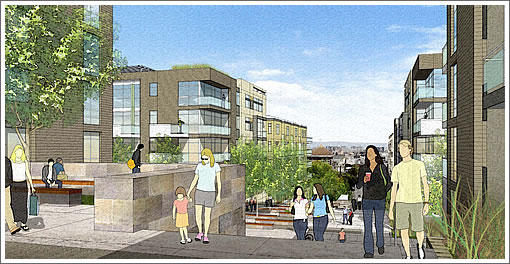
As proposed, the 55 Laguna development will yield a total of 413 new housing units including the 85-unit OpenHouse development for seniors targeting the LGBT community.
∙ 55 Laguna Back In Play [SocketSite]
∙ 55 Laguna: The Latest Rehabilitation Plans And Progress [SocketSite]

Although maybe not exactly bad in aesthetic, couldn’t they at least try to compliment the historical architecture? I’m not a historical preservation nut or anything, but the lines are just completely clashing with the original. A good architect would expand upon the best features, not make them look awkward.
[Editor’s Note: From the design team: “Though the new buildings are not compatible with regard to style and character, a balance of compatibility is achieved through other features that are sympathetic with the historic resources. The infill buildings are compatible primarily with regard to scale, materials [stucco], and color palette [neutral tones that relate to the colors of the historic buildings].”]
i salivate at the thought of this area of market street circa 2015, so many more people in the area. sf is slowly improving before our eyes, amazing.
How do you mean “compliment” the historical architecture? Do you mean copy or imitate? Do you mean be similar to, or replicate?
With all due respect, you offer a misunderstanding of how new contemporary architecture should work adjacent to or part of existing historical architecture.
In fact, the preservation movement does NOT want new architecture to look like or imitate or even compliment old architecture at all. Each piece of architecture should reflect its’ own particular place in time. The new architecture, by being new and modern, will in fact, compliment the older buildings by allowing the older buildings to “stand out” on their own(those that will remain on this site.) Many of the older buildings on this site will be demolished: they have no historic value and/or are not functionally adequate.
Historic preservation does, in fact, respect new architecture to stand on its’ own merit, and be distinctly seen as “different and new” from the existing buildings.
The worst thing an architect could do to this site is re-create new buildings to match the existing older ones.
This looks to be a great project adding much needed housing, street activity and opening up urban views thru the new Waller Park.
Not bad. Nice European density.
No comment on the perpetual and unresolvable “preservation vs modern” argument, but…
“Mews Terminus” in both look and name, looks like some evil anthromechanical character from Japanese anime. Yikes. I’m no traditionalist, but I find myself longing for an “It’s A Wonderful Life”-inspired gazebo with Sousa band here, instead of a concrete and metal monster that looks like it will eat small children at the stroke of midnight.
more glass… thats the best way to appease everyone. If you don’t like the modern building in front of you, well, just look at the reflection.
It seems silly to me that none of the new buildings reach or exceed the height of the tallest existing buildings across the street from the this project. On much of two sides, there are multiple seven-story buildings with the greater ceiling heights associated with the 20s, 30s, and 40s. Surely at least a couple of the new buildings could have been so bold as to rise above them. Still, it’s better than the suburban complex height of four stories characteristic of so much that gets approved these days.
What about the rabbit? What will happen to the rabbit?
“Nice European density.”
I mean really, you couldn’t make this stuff up.
Its hideous, people. Just plain butt ugly.
Much of what developers call “contemporary” or “modern” is no such thing. Where are the trees? Greenery? The tiles will overwhelm any landscaping. The whole thing looks hard, like an all purpose office building.
There are no distinctive characteristics, there’s no character at all. European urban design isn’t about density, it’s about having new buildings that work with the old ones, with the traditions of the place. Density as a green idea is a myth perpetrated by developers because it makes them more money. Just as putting too many pebbles into a bottle makes getting them in and out all but impossible, so density forces large numbers of people into a confined space which must then have all sorts of concessions to getting them out of there daily.
Having been in both a high rise and a small apartment building and a home during an earthquake, I can tell you that the highrise was by far the most dangerous place to be. And I wasn’t one of those stranded on the upper floor for four hours.
I see lots of trees and greenery; a lot more than exists there now.
Let’s start addressing all the hideous treeless streets in SF with sidewalks wide enough to drive a Hummer down. San Francisco is one of the major treeless cities in the country, for a large city. NY and Chicago have far more tree canopy than we do.
This is the preservation movement gone wrong:
Woods Hall & Richardson Hall are mediocre architecture and terrible urbanism each turning blind walls to the street (slightly mitigated by some proposed new openings onto Laguna)
To make matters worse, they occupy the most public frontages of this block, leaving the new buildings – those with any hope of being open and inviting – to be stuffed into the mid-block.
What a shame.
@futurist – why are there so few trees on San Francisco streets? I really think the lack of trees in combination with the utilities still being overhead from “telephone poles” (except for post neighborhoods) makes many parts of the city feel harder than it should. Why does Presidio Heights have such wide well cared for sidewalks with large mature trees? Does anyone even walk in Presidio Heights? I don’t want to turn this into “class warfare” but if you don’t believe me, just take a walk on outer Jackson or outer Washington from Lyon to Arguello. Very VERY wide sidewalks without cracks, potholes, and all with huge pleasant treess and all utility wires are hidden underground. And thanks to Prop. 13, it is not always true that someone in Presidio Heights might be paying more in property taxes than some homeowners in other neighborhoods.
anoncurious,
I don’t live in the Presidio but I see trees on pretty much every street. I am in a coffeeshop now, looking out onto a street with trees. There are trees on the streets where I live and where I work. All of my haunts in the city are on streets with trees.
What percentage of streets must have trees? Just how many trees do you need in order to be happy?
Personally, I would gladly reduce the number of trees in exchange for a reduction in the number of beggars. Last week I was threatened by someone after I refused to give them money.
Of all the things that San Francisco is known for, insufficient trees are low on the list.
I would largely agree with you anoncurious: I’m not arguing.
Example: walk down Sanchez St. in Noe Valley from 24th to 30th: the sidewalks are approximately 18′ wide. Yes! Eighteen feet!. There are blocks with maybe 1-3 trees, all scrawny and not well taken care of.
My take: People don’t really care: Property owners don’t and renters could care less about making the city nice. You can walk by rental properties on Sanchez and see tons of trash and leaves that are NEVER swept up. The renters don’t give a rats ass about the quality of a neighborhood, and the property owners ( a lot of them) are simply too cheap and greedy to put in one damn tree in front of their building.
That’s how I see it; and that’s just one neighborhood.
@Robert, I have lived in urban neighborhoods in both Chicago (Andersonville and Lincoln Park), and Los Angeles and believe it or not, both of those cities really have a completely different type of streetscape with lots of trees and other plantings. Huge trees are a constant on almost every urban residential street in high density neighborhoods of Chicago, and I must admit that as a born and raised San Francisco Bay Area guy who grew up trying to hate L.A. I was shocked by how green many streets are down there. I think futurist’s point is that we could do better, and one should not have to spend 10 million on a house to have nice sidewalks and trees in this city. I own in the Marina, and the sidewalks and streets are more than wide enough for large trees and yet many streets here have almost none.
Thanks anoncurious: Yes, my point(s) are about the fact that we could do better, much better.
We do have some involved citizens and neighbors who have reduced their sidewalk from 18′ feet wide to 6′ wide by adding trees and curbside planting. The city has permits in place to allow for this greening. (For my part, I have done that with my own property, at my expense, to plant several trees and sidewalk landscaping; the neighbors love it and we have many more birds around because of my tiny patch of green) Getting some of my neighbors to do the same thing is still a major challenge.
But it really does take people, owners, renters alike to WANT to make a greener city.
http://4.bp.blogspot.com/-SGJcM9N1L9s/TemAPUuvoJI/AAAAAAAAgEk/Mkma5eAX1MM/s1600/LI-archi-ASD-521b.jpg
My question is do the overhead wires in San Francisco prevent us from having trees like this?
(images from Chicago)
http://3.bp.blogspot.com/-n6lOxJjYdVE/TemAfBObo1I/AAAAAAAAgEs/loeH4WYBiGo/s1600/LI-archi-ASD-525b.jpg
Absolutely beautiful shots of some great Chicago streets. Why can’t we have that?
NO, I don’t think overhead wires are a huge factor in having more trees or not. Plenty of examples of trees and wires co-existing in SF now.
The real issue I feel is DESIRE: SF residents must WANT a greener city, or it will not happen.
SF is a hard place for trees. Some of them, by change, grow up over an underground spring (or manage to get their roots into the sewer pipes) but most are hard-pressed to get through our rainless summers. Those that do survive long enough to grow beyond shrub-level height have to face the windstorms we get every ten or twenty years. Spread out along sidewalks these trees don’t have the protection of a dense forest to keep out the gales.
Add to that the city’s practice of forcing building owners to maintain sidewalks buckled by tree roots, the dollar value of a skyline view (vs. a view of a tree), and you have a brew that is ultimately toxic to trees. Its a wonder we have any at all in this town.
As an aside — most of those east-coast city tree-canopies were planted about a hundred years ago, and many are at or beyond the end of their natural livespans. It is unclear that 100 years from now they will have anything like their present canopies.
looks pretty good, could stand to be have two or three taller structures mixed in to break up the rooflines. great that this property will finally be utilized again. also i don’t understand the complaints about the supposed lack of trees. the site plan shows well over a hundred trees. i don’t see how you could fit more in the available space.
I always enjoy the tree debates…. Around is right, SF can be a really brutal place for trees. I planted trees at my place and they do reasonably well because I provide irrigation and they’re comparatively sheltered, but neighboring trees look positively tortured. Soil quality changes block by block and we’ll never have the weather that makes, say, NYC street trees so idyllic. Also, the BUF kind of annoys me planting these wispy looking twigs that either die of neglect or are beaten into oblivion by the wind. All that said, Divisadero looks much nicer with the planted median as does Guerrero. I’d love more mature plantings done throughout the city, but I doubt most neighborhoods are going to make trees, or even drought tolerant sidewalk plantings, a priority any time soon.
Plenty of trees in SF. They’re more likely to be inside blocks though.
Also, SF’s climate is very different from Chicago. Chicago can be very hot in the summer and can definitely use the shade. SF, not so much.
Now, no-one answered the question: what will happen to the rabbit?
Love it that Google’s software automatically obscured the faces on the mural.
at least their algorithm didn’t confuse the pink silly rabbit with a human.
The tree and telephone pole shown in first picture above are hardly worthy of a world class city. There are not “plenty” of trees compared to Portland or Seattle which also have a Pacific climate. We can and should do better!
@anonfedup — I’ve planted trees on my street and encouraged/helped neighbors to do the same. What have you done to help us “do better?”
The fact is it takes initiative and continued upkeep to keep street trees thriving and most people don’t want any part of either.
The fact is it takes initiative and continued upkeep to keep street trees thriving and most people don’t want any part of either.
That or they still have old sewer pipes that haven’t been clogged yet and want to keep it that way as long as possible.
Blaming a treeless city on renters? Get out of here you troll! Maintaining properties is the responsibility of the property owners. Period. Get off your lazy ass and sweep the sidewalk of the place you OWN. You’re already getting a Prop 13 tax break and inflated rent payments.
The biggest threat to trees in this city are all the people who want a view from their unit.
This love of views destroys more trees than the winter storms. Take a walk down any street in the city and you’ll see shameless butchering everywhere.
If you want trees planted in your neighborhood, contact Friends of the Urban Forest. They can recommend appropriate trees for our climate and give planting/care instructions. If you care for the tree properly during its first five years, rainless summers won’t be such a big deal.
They can also help you report tree butchering to the bureacrats … hello hefty fine!
You missed the point of the discussion moz: When renters (who are part of our city and enjoy all the benefits ALSO show they care about clean sidewalks and trees, we will have a cleaner city and perhaps more trees.
Of course, property owners are legally responsible for the upkeep, but I can show you block after block of trashy sidewalks in front of rental properties. Is is so difficult to share in the occasional sweeping of the sidewalk full of trash?
When we ALL take part in our city, the city will get better.
Yes, and I know a few on my street. Rental buildings are also the ones where bums will set up camp more often. It’s the “I am paying zzz dollars a month, why should I sweep/care?” mentality.
All my owner neighbors paid $1.2 to $1.5M+ for their places, and they all know how to use a broom.
Yes, and I know a few on my street. Rental buildings are also the ones where bums will set up camp more often. It’s the “I am paying zzz dollars a month, why should I sweep/care?” mentality.
While I’m sure you would like to receive unpaid labor from your tenants, sweeping the streets is the responsibility of the landlord. Seriously, this city is home to the most incompetent, uncaring, neglectful landlords in the nation.
Is is so difficult to share in the occasional sweeping of the sidewalk full of trash?
No, it’s not. Listen, why don’t you give tenants a free pass every once in a while on paying the rent, and they will give you a free pass every one in a while and maintain your property for you?
Sure, Robert. There are many situations where landlords are not doing their jobs. Maybe the landlord needs a reminder from his neighbors he should take care of this or get 311-ed…
But in the mean time, it doesn’t hurt to to pick up a broom once in a while. I sweep my neighbor’s sidewalk when he’s gone, and he does the same for me.
Oh god, this has degenerated into an owner/renter debate..we haven’t had one of those in a while. I happen to rent right now, and I do my duty on occasion and sweep my sidewalk. But it is naive to think that tenants are going to feel like that is their role, particularly in multi-tenant buildings where it is even more difficult to feel ownership/responsibility over common space. And that DOESN’T make owners more virtuous, just more invested, both financially and emotionally in the neighborhood.
But DON’T blame tenants for the lack of greenery. We asked our landlord for permission to put in a street tree (and offered to pay the FUF fee), but he declined. The reality is that the City’s insane Nazi policies on sidewalk cracking keep a lot of people from wanting trees, because they see them as a liability. This is also the reason that so many people “lollipop” their trees, or plant small varieties to start with, to prevent sidewalk cracking. It is very discouraging.
Just as I thought might happen, a bunch of excuses as to why we don’t have a great tree canopy. Excuses, excuses, excuses.
Sidewalks still crack in Chicago and NY. Soil is not perfect in Chicago and NY. They have overhead wires and poles also. And on and on.
BTW: the comment “unpaid labor from your tenants” is a new low in excuses and self-entitlement.
“Why should I do anything in life except something that benefits me directly and for which I am adequately compensated.”
Welcome to San Francisco.
“At 12%, San Francisco’s tree canopy cover remains considerably under the 22% national average”
“Even at more than 5,000 trees per year as of 2006, San Francisco’s tree-planting efforts were modest compared to other cities in California and throughout the world. That year Los Angeles announced plans to plant one million trees,”
from wikipedia page on San Francisco Tree Canopy.
I’m not impressed with the architecture or design, but it crams lots of people into an area that can use them (to bring Market St. back to life between Van Ness and Church), so just build it!
Sure, Robert. There are many situations where landlords are not doing their jobs. Maybe the landlord needs a reminder from his neighbors he should take care of this or get 311-ed…
But in the mean time, it doesn’t hurt to to pick up a broom once in a while. I sweep my neighbor’s sidewalk when he’s gone, and he does the same for me.
Sure, and I sweep my back-porch, too. But what you are describing — a persistent situation of garbage on the streets — is not about occasionally doing someone else’s job. Clearly the landlord has not hired a professional to clean his property on a regular basis.
My unit is professionally managed. A person comes out twice a week to vacuum the common indoor areas, check that the light bulbs are not burnt out, sweep the common areas, clean the windows as necessary, a gardener comes to care for the plants in the common garden, etc.
So why don’t the tenants do that? The reason I am renting is so that I don’t need to bother with those things. If I want to do gardening, I can rent a plot and do it. But as I have no interest in gardening, I don’t do it.
I am willing to pay to let someone else manage the property. It is no different than demanding that owners in a multi-unit condo spend time vacuuming the common hallways, hosing down the patio, or taking out trash each day from common areas. That is why they pay HOA fees.
Of course, if I have a BBQ in the back, I will not leave trash lying around, but will clean up after myself. But that is not a substitute for regular professional cleanings.
The problem is when you have a large amount of small time accidental landlords, many of whom are retired and inherited their property, or purchased it for asset management purposes and don’t know a whole lot about their legal responsibilities and are not invested in the neighborhoods in which their properties reside.
They may not even live in the area — and then they decide to maximize their profits by not hiring a professional manager, but instead do a poor job of managing the property themselves.
Property management is skilled work, and must be paid for. Sure, you get more in short term profits if you skip that step and just collect rent checks, but then don’t expect your tenants to provide those services for you at no charge.
If you are a landlord and are not paying someone to regularly go by each of your units and take care of the common areas, then you aren’t doing your job as a landlord.
^I’m going to go ahead and guess that SF’s “building cover” is also substantially higher than the national average, meaning that we better start tearing down buildings and planting trees in their places in order to match the average…
Also, LA has a mountain range within its city limits. If we annexed Marin we could probably plant a million trees too.
You guess wrong “anon”. But whatever is posted someone will claim some excuse for why we cannot have trees like Chicago or Seattle or Portland or Los Angeles or ….. If we were to post Chicago’s tree cover percentage, you would say that is because they have more parks, if we post NYC, you will say that includes Staten Island, etc. etc. and excuses excuses. Does it not get boring having to always try to cast a blind eye to San Francisco problems and inventing new excuses why other urban areas are not sometimes doing things better.
Wanting to include better streetscapes and landscaping in our city, and pointing to excamples in other cities would not be a problem if you were talking to Chicagoans or New Yorkers but little San Francisco just cannot handle the criticism. As futurist noted, first people claimed broken sidewalks from tree roots, then poor soil, and now “building cover”. Why are some San Franciscans unable to admit the problems sitting right in front of them?
@Robert
What you describe is the how the contract between landlords-tenants should work. However, when you add rent control into the equation where rents increase at 60% of CPI (already understated for housing expenses) landlords tend to neglect such services. Given that tenants are loathe to pay market rates, they tend to stick it out regardless of whether upkeep of the property is performed. In a perfect world, tenants would vote with their feet and move when such services were not performed. In SF, this just doesn’t happen and we are left with a substandard rental housing stock.
@ Robert: your comments leave me disappointed.
Yes, property owners/landlords should be responsible and take care of their properties, both the private spaces AND the public sidewalk. In fact, keeping the sidewalk clean and debris free is mandated in a particular DPW code section.
But what’s the big deal about ONCE IN BLUE MOON, maybe, just maybe a renter walks out his/her front door and picks up some trash? or maybe, just maybe sweeps the sidewalk?
There are some large rental properties that I know of (in Noe) where the trash has been swirling around the front steps for months. And that’s just one neighborhood.
I wonder. What exactly is the problem?
But what’s the big deal about ONCE IN BLUE MOON, maybe, just maybe a renter walks out his/her front door and picks up some trash? or maybe, just maybe sweeps the sidewalk?
There are some large rental properties that I know of (in Noe) where the trash has been swirling around the front steps for months. There are some large rental properties that I know of (in Noe) where the trash has been swirling around the front steps for months.
Do you see a tension between your two paragraphs?
If your neighbor goes on vacation once a year and asks you to water their lawn, you do it without demanding payment. If the same neighbor asks you to water their lawn every week, you demand payment or refuse to do it. You don’t even do it once.
The key part of “once-in-a-blue moon” is that it does not occur regularly. You cite an example of the landlord clearly never doing their job, and now expect the tenants to do it occasionally.
Let me ask you, if your property was next to an absentee owner that never visited the property to mow their grass, what would you do? Mow the grass once in a while? If you decided not to mow the grass, would I be right in complaining about your lack of civic-mindedness?
What you describe is the how the contract between landlords-tenants should work. However, when you add rent control into the equation where rents increase at 60% of CPI (already understated for housing expenses) landlords tend to neglect such services. Given that tenants are loathe to pay market rates, they tend to stick it out regardless of whether upkeep of the property is performed.
Yes, except the “market” rate is only the market rate because it is available to a small group of landlords. Either this city is filled with tenants earning $150K/year (good luck with that), or the median tenant that is earning $60K/year will continue to pay $800/month to rent their unit, and the market rate will adjust downward to reflect the true demand for housing in the city.
In a competitive market, the result of eliminating rent control is that landlords receive less in rent, but in exchange are not subject to the risks of having a few very long term tenants paying far below market rent.
It is a chimera — the wealthy tenant, just out of reach — that would only be your tenant if we got rid of rent control. But it is only because you cannot rent to that tenant that the tenant is willing to pay so much. You are talking about a dozen or so transactions closing each week, allowing the top dozen or so earners to rent each week. With hundreds of transactions closing each week, the median income would determine rents, but those rents would be available to every landlord.
So I would say that because the market is not clearing, tenants remain in their properties, in which case whoever is lucky enough to have tenants move out can receive a premium. It becomes a lottery in which the quality of housing services becomes disconnected from prices paid, and this is why landlords are loathe to maintain their properties.
I understand that dynamic, but what I don’t understand is the argument that when a landlord neglects their property, the tenant should step with volunteer labor. The landlord either bought the property knowing the rent control laws, or they bought the property so long ago that the Prop 13 subsidies they are receiving are far in excess of any loss of rental income that they could expect. In either case, it is pure self-entitled greed on the part of the landlord, and not “tenant neglect”.
Good grief Robert. You don’t get it.
You comment ad nauseum about tenants rights and landlord tenant contracts.
Jeezus……
All I was talking about is how we all chip in (together) once in damn while to sweep the sidewalk in front of our residence. OF COURSE the property owner should keep the property (sidewalk) clean. But by your logic the renter person, god forbid, should NEVER go out of his/her way to do a nice deed. That’s the entire essence of the San Francisco renter right there.
Sorry I mentioned it. Way to much to expect from most people in SF.
Good grief Robert. You don’t get it.
I’m sorry, futurist, I get it now.
Initially I thought your comment was just more endless self-righteous landlord b*tching about how “renters don’t give a rats ass about the quality of a neighborhood”.
Now, I see that you were just being civic minded.
You are right, regardless of whether there is any financial incentive — either from your own property being better kept or from that of your immediate neighborhood — we should all chip in to keep San Francisco beautiful.
I am sorry for ascribing hypocritical pecuniary motivations to you, as indeed, we are all one community, and so I look forward to seeing you clean up Sanchez Street.
I will walk by there next week to see to check on your progress. Perhaps, in the future, a lowly renter such as myself can learn from a property owner that it really isn’t at all about money, and one day I, too, will care for the city as much as you do.
In my former tenant life, I used to clean and hose the sidewalk every month or so. My former landlord is a nice guy and was always correct and friendly to us. I tend to look beyond the written rules to make my surroundings better. Care about what happens in the area, be involved and exchange ideas, time, services and information. Your neighborhood will be better for it.
Or we can be a city of self-centered pr@cks as most of the country already sees us. See the South Park “Smug Alert” episode. So true sometimes.
In my former tenant life, I used to clean and hose the sidewalk every month or so.
Was that in SF? What year?
I did that once and received a written letter that the hose was not for tenants to use. Someone had complained. I wonder what would happen if, say, in a big place like One Rincon, one of the residents started hosing down the common areas. Times have changed.
In all this discussion, no one on the pro-tenant sweeping side has admitted that there is a huge difference between a one or two unit building and a “large” one (like those alluded to by futurist with “trash swirling around the front steps for months”. In the case of a long term renter in a small unit, they may indeed take on some “ownership” of sidewalk, etc. But in a large rental building, no individual renter is going to regularly take on the responsibility unless they are a saint. In that situation, management of the building is more properly a business and should be organized as such….often a multi-unit building will have an on-site manager paying low or no rent to keep track of these things.
And on trees….in all my traveling around the States I have not seen a city as aggressive about maintaining sidewalks as SF (a cost which is born by the homeowner). Somehow in a place like Boston, undulating brick sidewalks are just fine…but here one tiny crack in a flat as a pancake sidewalk requires replacement. The collusion between ADA concerns and the pavement contractors is mind numbingly bad public policy. Yes, this is my pet peeve, but this just happened in my neighborhood in the Mission last year, and nearly half of the pavement on my block was tagged , much of it for completely inconsequential damage that didn’t come close to impeding ADA access. Guess what happened afterwards…my neighbor across the street absolutely butchered his three beautiful plum trees so badly that they are barely alive. San Francisco will never have a midwestern or eastern tree cover..the natural state of this city is a windswept sand dune after all. But it could be a LOT better, and public policy is partly to blame.
Robert,
Yes, in SF and in 2010. Nobody would complain because everyone benefited. Of course I had a small perk: being allowed to quickly hose down the dust off my car once in a while. And doing whatever I wanted with the garden.
Robert. I can’t tell the difference from your (perhaps intended) sarcasm and positive statements.
I never said in ANY of my previous comments that we all should be charged with cleaning up streets we don’t live on. I don’t live on Sanchez St. but I have picked up trash and put it in the nearest receptacle.
You know that I really was referring to sharing in the sidewalk cleanup in front of the building where that person lives: renter or landlord. And I never said nor implied that renters were “lowly”.
@curmudgeon: I’m not really sure what defines a large rental building or not. I was simply thinking of some “larger” buildings in Noe, maybe 6-10 units, within the context of my statement.
But you guys don’t have to do anything. Leave the sidewalk messy if you want. It’s a personal choice. It’s just that, as lol says, we have a lot of self-centered…people…in SF.
I’m not out to save the world, just to do my small part in making it better.